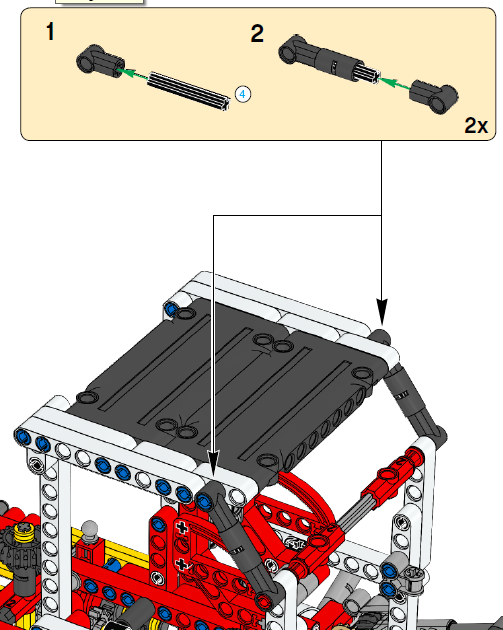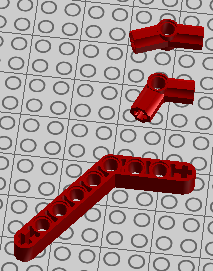As you may know, the sides of a right angled triangle (a, b, c) satisfy:
a 2 + b2 = c2
(1)
Vice-versa, if the sides of a triangle satisfy (1), then it is a right angled triangle. But what have this theorem ever done for us?
This latter form of the theorem allows us to build cross beams with lego. The Lego has a unit, in both Lego and Technic, the dimensions of any parts are the multiple of this unit (except some half length parts).
This unit allows only positive integer solutions of the Pythagorean equation, which is exactly why it is an important equation.
Let us see some manifestations of the famous (and smallest) Pythagorean triple: 3-4-5. LDD files here.
On the first example you can see that I used a 5 beam and a 2×4 L-shaped beam and a 7 beam (actually only 6 holes of it).
You may think that the sides of these triangles are acutally 4-5-6, bigger than the theoretical 3-4-5 triple.
This is because the length of the beam is one unit bigger than the actual centers of rotation.
Like this fellow:
It is 4 units long, but the center of the two holes are 3 units wide from each other. See the cardan joint, the calculation is a bit different for that. The Pythagorean triple should appear as the distance of the rotation centers, not the total length of the beam or axis.
Now you can design your own Pythagorean constellations in various places. Let us see an examples in an official Lego Technic set.
- The windshield of the 42000-B set, the racer truck.
- The wing door of the 8448 street sensation car
There are other Pythagorean triples then 3-4-5. An other small triple is 5-12-13.
An example for that is in the 5_12_13.lxf file.
Some bricks incorporate the 3-4-5 or the 5-12-13 triple, further examples in the second LDD file.
Some bricks incorporate the 3-4-5 or the 5-12-13 triple, further examples in the second LDD file.
Since the 3-4-5 and the 5-12-13 are both Pythagorean triples, the cuboid with sides 3-4-12 has an interesting property. It has an integer side-diagonal, and its space-diagonal is integer too.
Anyway, it is useless in Lego, because you should have two sphere joints to build this cuboid with its space-diagonal.
However, you may use other Pythagorean triples in 2D, here are some:
- 3-4-5
- 5-12-13
- 7-24-25
- 9-40-41
There is an overall formula to get every triple. For any positive integers z and x, for which z is greater than x:
z2 - x2, 2 x z , x2 + z2
gives a Pythagorean triple.
Good luck!
Good luck!





















